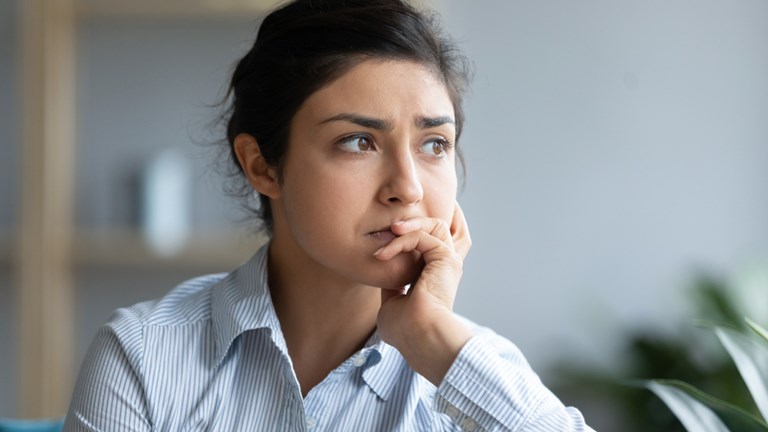While most people feel anxious from time to time, for some, anxiety is a big part of life and can interfere with everyday activities. Generalised anxiety disorder (GAD) is a long-term condition that triggers feelings of anxiety about a variety of issues and situations rather than a specific event, and it becomes a constant battle to ignore them.
The condition is more common than you might think. It’s estimated that up to 5% of the UK population is affected by GAD; slightly more women than men are affected by the condition and it’s more prevalent in people aged 35-39.
One type of anxiety is Situational anxiety which commonly occurs in response to a specific situation. Situational anxiety is highly common and, in many cases, it is normal, as it can occur in response to specific situations, like public speaking or a job interview. While situational anxiety is not recognised as a distinct anxiety disorder, according to the NHS diagnosis of Generalised anxiety disorder (GAD), however if an individual’s symptoms interfere enough with their daily life, they may meet the criteria for phobia.
What is situational anxiety?
This is a type of anxiety that is triggered before a known situation, such as a performance, examination, job interview or public speaking, rather than generalised anxiety.
You may feel fearful or overly nervous in certain situations and symptoms can manifest in the form of trembling or shaking, dry mouth, dizziness and heart palpitations among others. These symptoms, which are sometimes referred to as panic attacks, can be brought on by triggers, such as being in a crowded space.
Symptoms
Situational anxiety is a form of anxiety that occurs in response to a specific situation, such as an interview. You may feel fearful or overly nervous in certain situations and symptoms can manifest in the form of trembling or shaking, dry mouth, dizziness and heart palpitations among others.
Symptoms of situational anxiety may include but not limited to:
- feeling nervous and/or strained
- tiredness and exhaustion, often combined with insomnia
- sweating
- sickness
- chest pains
- irritability
- headaches
- rapid breathing
- inability to carry out daily tasks
While situational anxiety is not recognised as a stand-alone illness like a generalised anxiety disorder (GAD), it has certain features that GAD does not. The biggest difference is that this kind of anxiety is not constant but is triggered by specific situations. Often, trigger situations such as standing in a busy lift or walking through a crowd, cannot simply be avoided every time and we will encounter them at different points during our lives, which is why treatment is still important.
Causes
There are many things that can trigger a person to suffer from situational anxiety and it’s normally related to something new, upcoming, or changing. Something new might include a new job or new relationship, something upcoming might include a job interview or medical appointment and something changing might include moving house or experiencing money problems. Situational anxiety can also be caused by less rational things though, that usually involve a certain amount of pressure; driving in traffic or riding in a busy lift.
Of course, every person will experience one of these triggers at some point in their life but not everyone will suffer from situational anxiety over it. This is because there are specific causes of situational anxiety including genetics and other medical conditions. You can also be more likely to suffer from it in this digital day and age because of the lack of human interaction and connection. If you have previously abused drugs, or even have a high intake of alcohol or caffeine then you may notice situational anxiety.
Triggers
There are a number of different factors that can contribute to situational anxiety. It tends to be triggered by new or changing situations. Because people are unsure of what to expect or how they should respond, feelings of anxiety can emerge.
Situational anxiety can be linked to a number of different settings, experiences, or situations. Some of the most common triggers include:
- First day of school
- Job interviews
- First day at work
- Meeting a person on a first date
- Traveling to a new place
- Being away from home
- Speaking in public
- Meeting people at a party
- Leading a group
- Social situations
Major life changes can also trigger feelings of situational anxiety, such as your wedding day, the birth of a child, or moving out to go to university. Unfamiliarity are common themes for many of the situations that trigger situational anxiety. It’s normal to feel anxious in the face of situations where you aren’t sure what to expect or what might happen. In many cases, situational anxiety begins to lessen once the situations become more familiar, which can be helped with therapeutic approaches.
Situational Anxiety Treatment
For many people, situational anxiety treatment can simply be a case of avoiding the situation that causes the anxiety or panic attacks. However, this may not always be possible as the situation that is causing the problem is part of normal life and it cannot be avoided, and so a little help is needed.
In general, there are a number of self-help approaches that can reduce feelings of anxiety, which are outlined further in the blog. However, situational anxiety is often treated with psychological treatment based on CBT or long term medication, such as Propranolol.
Propranolol is a beta blocker which can be very helpful in controlling symptoms such as heart palpitations, excessive sweating and trembling. By stopping these symptoms, it can be of great help in stopping the anxiety from taking hold and controlling you. It can be used when you know that the situation that causes your anxiety will be faced, or it can be taken on a more regular basis if needed.
To have a confidential and convenient situational anxiety consultation with our UK registered GP click here.

Methods to cope with situational anxiety
If this sounds all too familiar, we’ve compiled a number of anxiety management tips and strategies that may help to ease your worries and symptoms:
Get active
Whether dancing, running, swimming or something else entirely, getting active has been clinically proven to raise the body’s serotonin levels, and the more ‘feel-good hormone’ serotonin in your body, the more relaxed you’ll feel. Getting into a regular exercise pattern can help you look, feel and function better – which may ease feelings of anxiety.
Avoid caffeine
If you drink too much caffeine, it could actually leave you feeling more anxious than normal. Caffeine is known to disrupt sleep as well as speed up the heartbeat. Avoid coffee, tea and energy drinks if possible, as they contain caffeine. By doing so, it may help to reduce your feelings of anxiety.
Break the situation down
Try not to feel overwhelmed by the size of the situation that is causing anxiety – break it down into smaller tasks, then tackle them one by one. Give yourself reasonable deadlines to complete each one and tell yourself you can achieve it – it’s much more manageable and not nearly as daunting this way.
Forget about the ‘what ifs’
One of the biggest causes of situational anxiety is letting fears about worst case scenarios spin out of control. It’s natural to worry about the ‘what ifs’ of a situation, but the worst very rarely happens. If you start thinking this way ahead of an interview or an office presentation for example, turn your attention to your past successes instead. Remember that minor slip-ups are human nature and most people are very understanding of them.
Practice makes perfect
The thought of speaking in public can leave some people terrified, but the easiest way to overcome the nerves is to practice your speech early and often. Give yourself every chance to get comfortable with the wording – that way you will be better prepared and more in control of the situation on the day.
Don’t forget to breathe
Sometimes, when experiencing a distressing situation, our breathing can change and speed up. Controlled breathing is a simple technique that encourages you to focus and slow down your breathing patterns, in order to help you manage your feelings more effectively and restore calm. Manoeuvre into a comfortable position then begin to concentrate on a stable breathing rhythm. For example, breathe in for three seconds, hold for two seconds and then breathe out for three seconds – and repeat for a few minutes. This technique should help you feel calmer and after a few minutes, ease any dizziness you may be experiencing.
Anxiety comes in many different forms but while it’s not easy to live with, there are things you can do to help ease its effects. If you’re dealing with situational anxiety, medication such as propranolol is also an option and, if you need to talk to a professional, Pharmacy2U’s online doctor service is always on hand to offer confidential advice.
